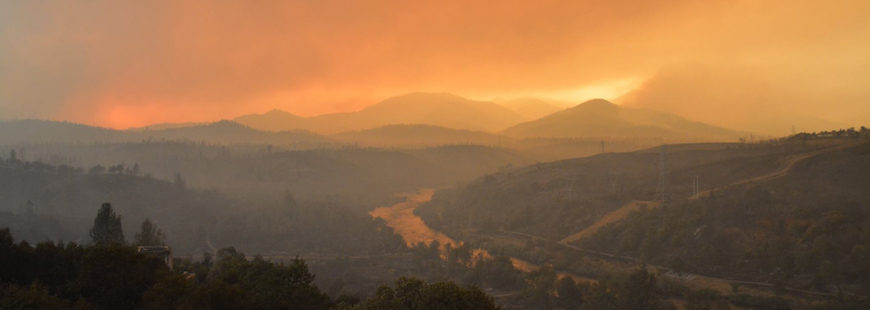Photo: Carr Fire, via Wikipedia
My family’s 10-acre textile farm is 20 miles away from the spot where the infamous Carr Fire, near Redding, California, started. I happened to check the California fire map before heading to Whiskeytown Reservoir for some relief from the 106° heat. Carr ultimately burned 230,000 acres, killed 8 people, destroyed 1,604 buildings, and burned 39,000 of Whiskeytown National Recreation Area’s 42,000 acres.
I wasn’t at all surprised when I saw a new fire had started. Summer days in Palo Cedro regularly include checking the fire map to figure out where the smoke is coming from and to make sure the latest blaze is a relatively safe distance away. Fires are a natural part of the chaparral and forest ecosystems that dominate Shasta County. Many have previously evacuated or lost a home to wildfire. The farm was in the path of the Jones Valley Fire in 1999 and was only saved thanks to our agricultural sprinkler system.
As someone for whom wildfire is a very real threat, Donald Trump’s first presidential tweet that has anything to do with fish or water was insulting to me personally. The President wrote, “California wildfires are being magnified & made so much worse by the bad environmental laws which aren’t allowing massive amounts of readily available water to be properly utilized. It is being diverted into the Pacific Ocean. Must also tree clear to stop fire from spreading!”
Unfortunately for those of us who want water, fisheries, and firefighting solutions that work, the President has shown a lack of understanding of California’s river systems and water policy. Not long after his first tweet, Mr. Trump also tweeted, “Governor Jerry Brown must allow the Free Flow of the vast amounts of water coming from the North and foolishly being diverted into the Pacific Ocean. Can be used for fires, farming and everything else. Think of California with plenty of Water – Nice! Fast Federal govt. approvals.”
The President seems to believe that naturally flowing river systems are abnormal; the salmon fishermen I work with beg to differ. Firefighters are always allowed as much water as they need to fight blazes, a fact that the state firefighting agency CalFire has acknowledged after Trump’s tweets. Blaming California’s decision to allow some water to stay its natural course in order to promote healthy fisheries is baseless, inflammatory, and dangerous.
Hot on the heels of the California water twitterstorm was a directive from Commerce Secretary Wilbur Ross to maximize water deliveries for agriculture. Those operating outside the raging “California Water Wars” may scratch their heads wondering why the Commerce Secretary’s wildfire response would focus on agriculture, rather than water or fish. Sending more water to farmers in the Central Valley would only reduce the amount of water in our reservoirs, ultimately reducing the amount of water available to firefighters.
It is clear that the attention that was being paid to our wildfire crisis is not about addressing fires at all. Rather, it’s an attempt to undermine Magnuson-Stevens Act protections for essential fish habitat, and Endangered Species Act protections for stream flows that protect salmon, in order to deliver more water to Central Valley farmers. But for salmon and salmon fishermen in California, the political grind could be too much to bear.
Fires have always been on our minds July through October, but the number of devastating fires in California has only increased in recent years. This has nothing to do with letting some water flow its course to the Pacific Ocean and everything to do with man-made alterations to our ecosystems and atmosphere. Climate change is increasing the length of fire season and causing conditions that encourage fire growth and make firefighting more difficult. Climate change is also magnifying the impacts of our increasing diversions in an already-overappropriated river system in Northern California.
The President should look to California for a lesson on how to address wildfires, including how to fund them. After all, the vast majority of land that has burned in California in the past several years is managed by the Departments of Agriculture and Interior. While federal funding to lower fire risk is stuck in budget negotiations, California has allotted $256 million this year from the state’s program to reduce greenhouse gas emissions. We need to put the blame on climate change where it belongs, and address the root causes while reducing risk, easing firefighter’s jobs, and supporting victims instead of using fisheries protections as pawns in a water grab.


